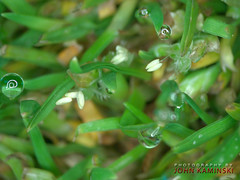 Everyone that has sat through a pathology or disease lecture has heard of the disease triangle. Consisting of the environment, the pathogen, and a susceptible host, the disease triangle is a critical component of understanding disease pressures on a golf course. In a previous post I talked briefly about the importance of the environmental (weather) component of the triangle. I thought that as we wrapped up the season in the Northeast, I would take this time to speak about the importance of the host.
Everyone that has sat through a pathology or disease lecture has heard of the disease triangle. Consisting of the environment, the pathogen, and a susceptible host, the disease triangle is a critical component of understanding disease pressures on a golf course. In a previous post I talked briefly about the importance of the environmental (weather) component of the triangle. I thought that as we wrapped up the season in the Northeast, I would take this time to speak about the importance of the host.Unlike cropping systems where the purpose of the host is to grow a plant as large as possible and harvest it for sale or distribution, turfgrass managers must deal with a perennial crop that hopefully remains healthy forever (or at least for a long period of time). So instead of just trying to get to harvest, we must figure out a way to manage the "crop" during the good times and the not-so-good times. In the Northeast, just about all of the typical cool-season turfgrass species are grown and in the transition zone of the region we even grow a few warm-season turfgrasses. Growing grass in this region can be very difficult. Taking the extremes in weather out of the equation, there are still some important things about the host to take into account when identifying and managing turfgrass diseases.
 When I first take a look at a turfgrass sample, identification of the genus and species is the first step of the process. Remember to look for key attributes including the vernation, ligule size, leaf tip, growth habit and other key components, Simply identifying the species can eliminate numerous pathogens as potential causes of the problem in question. For example, take-all patch is primarily a disease of creeping bentgrass. If the species affected is primarily annual bluegrass, then this disease can be ruled out (not to mention that take-all is primarily a disease of young putting greens of which little ABG would be present). To the contrary, a patch disease appearing primarily on annual bluegrass could limit the possibilities to summer patch or necrotic ring spot (or possible nematodes). Although summer patch may be present on bentgrass in the extreme heat of the Southeast, it is rarely (never to my knowledge) been identified on bentgrass in the Northeastern United States.
When I first take a look at a turfgrass sample, identification of the genus and species is the first step of the process. Remember to look for key attributes including the vernation, ligule size, leaf tip, growth habit and other key components, Simply identifying the species can eliminate numerous pathogens as potential causes of the problem in question. For example, take-all patch is primarily a disease of creeping bentgrass. If the species affected is primarily annual bluegrass, then this disease can be ruled out (not to mention that take-all is primarily a disease of young putting greens of which little ABG would be present). To the contrary, a patch disease appearing primarily on annual bluegrass could limit the possibilities to summer patch or necrotic ring spot (or possible nematodes). Although summer patch may be present on bentgrass in the extreme heat of the Southeast, it is rarely (never to my knowledge) been identified on bentgrass in the Northeastern United States. So being able to identify the species at your course can save you a lot of time and increase your chances of making an accurate diagnosis. There are too many diseases to talk about in this post, but below are some common hosts of typical diseases found in the Northeast.
So being able to identify the species at your course can save you a lot of time and increase your chances of making an accurate diagnosis. There are too many diseases to talk about in this post, but below are some common hosts of typical diseases found in the Northeast.Anthracnose basal rot: primarily annual bluegrass, occasionally creeping bentgrass (does not occur on both species on the same green)
Brown patch: most species, but tall fescue, perennial ryegrass, and bentgrass (particularly colonial bentgrass) are most susceptible
Dollar spot: all species susceptible, particularly important on bentgrasses
Summer patch: Kentucky bluegrass and annual bluegrass, also fine leaf fescues
Take-all patch: creeping bentgrass
Sometime prior to the end of the year, I will wrap up the discussion of the disease triangle with every pathologists most favorite component...the pathogen!
For a disease update, things are just about shut down, but dollar spot did pop up in recent weeks and microdochium patch continues to be active at select regions in the Northeast.


















2 Responses to “The Disease Triangle (part 2): The Host”
Thanks for the post John. The importance of the host is part of what I test in the Turf Bowl. When I put out the disease pictures or describe a disease a key component is what is the host.
Now if any of you bloggers have great disease pictures (with a description of the host) or great pathology questions for the Turf bowl I always welcome help.
I am trying to develop banks of questions for easier prep and grading.
Leah, when would you need pictures by? I am always looking to upgrade the images for the turf bowl...they are too easy!
John
Post a Comment